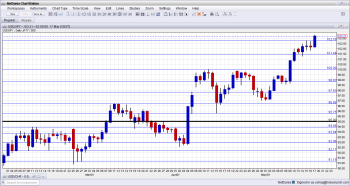USD/JPY continued its surge higher and hit fresh highs. Without a pullback, can the pair continue higher? The rate decision and BOJ governor Haruhiko Kuroda’s speech are the main market-movers this week. Here’s an outlook for the Japanese events and an updated technical analysis for USD/JPY.
Last week The Japanese economy enjoyed firm growth in the first quarter of 2013, rising 0.9% in January-March, the quickest growth in a year. Shinzo Abe’s radical monetary policy is finally bearing fruit. Deflation is improving and the yen is weakening. Furthermore, Japanese core machinery orders edged up 14.2% in March beating forecasts for a 3.1% growth, the fastest growth in 8 years. In addition, also the BOJ contributed with an immediate plan to “calm the bond markets” and injected more money. In the US, economic indicators are not so good, but the dollar certainly has a reason to rise. Let’s Start:
Updates: Japanese economy minister Akira Amari said that “excessive JPY gains have been corrected a lot” and that “ it’s the government’s responsibility to “minimize” that effect”. USD/JPY dropped as low as 102 before rebounding, and trades around 102.40, far off from the highs of 103.30 seen on Friday. USD/JPY extended its fall on the not-enough hawkish statements from Evans, an FOMC member, and is at 102.25.
- All Industries Activity: Tuesday, 5:30. Japan’s all industry activity improved in February, rising by 0.6% after a 1.6% fall in January. The expansion occurred mainly due to a recovery in tertiary activity. The increase was contrary to market forecast of a 0.6% decline. On a yearly basis, all industry activity dropped 2.5% in February compared to a 0.7% fall in the previous month. A drop of 0.3% is expected now.
- Trade Balance: Wednesday, 0:50. The March seasonally adjusted trade balance deficit reached Y922 from Y1.09 billion deficit in the previous month. The 1.2% drop in deficit occurred due to a rise of 1.6% in exports from February and 2.4% on the year. The unadjusted merchandise trade deficit was a smaller than expected reaching Y362.4 billion from a year ago. An improvement to -0.61T is forecasted.
- Monetary Policy Statement and BOJ Press Conference: Wednesday. The Bank of Japan kept monetary policy unchanged in April, in line with market forecast, following exceptional stimulus measures declared earlier that month to meet the 2% inflation rate target in two years. The BOJ switched its policy target from the overnight call rate to base money, a broad measurement of the amount of money the central bank pumps into the economy. No big change is expected this time, as the ambitious decisions from the important April 4th meeting are still being digested by the markets.
- BOJ Monthly Report: Thursday, 6:00. The Bank of Japan announced an unprecedented decision to inject about $1.4 trillion into the economy in less than two years. The new Governor Haruhiko Kuroda said the monetary base would nearly double to 270 trillion yen ($2.9 trillion) by the end of 2014.
- Haruhiko Kuroda speaks: Friday, 3:55. BOE Governor Haruhiko Kuroda will speak in Tokyo. He may talk about the positive developments in Japan’s economy over the recent month and about the new monetary policy. His words can cause volatility in the markets.
*All times are GMT.
USD/JPY Technical Analysis
Dollar/¥ began the week holding above the 101.44 line (mentioned last week). It then climbed and marked a top at 102.80. After a long struggle with this line, the pair finally made a breakout, rising above 103 and closing at the high level of 103.21.
- Technical lines from top to bottom
We start from higher ground once again.: 108.60 capped the pair in 2008 and worked as support during 2006. 107.16 provided support in 2007 and later worked as resistance in 2008.
105.50 is above the round number of 105 and worked as resistance during 2008. It worked as support later in the year. Below, 104.60 slowed the pair’s rise in early 2008.
103.50 is a strong line that worked as support for the pair in July and September 2008 and is a key to any strong upside move. 102.80 capped the pair in May 2013, and could work as the immediate pullback line.
101.80 worked as a cushion for the pair in May 2013, and it is minor support now.. The 101.44 line, which was the post crisis high seen in April 2009. is now critical support.
The obvious number below is the very round number of 100 and would be closely watched on any drop. 98.90 capped the pair in June 2009 and serves as minor resistance.
A stronger line is the 97.80 line, which was a peak back in 2009 and was reached in April 2013. The pair stumbled below this line, which is getting weaker. The round 97 line worked as important support in May 2013.
The March 2013 peak of 96.71 is the next line, which now switches to support. 95.88 provided a temporary stop on the way up and was also the swing low on a fall during April. The round number of 95 is also watched by many and will remain critical support on a reversal.
I temporarily turn from bullish to neutral on USD/JPY
The long term direction of the pair remains up: the extreme monetary and fiscal policies coming from Japan are likely to push the yen lower across the board. In the US, the fiscal tightening and the hints about unwinding QE as soon as this summer can boost the dollar across the board.
However, forex trading is usually not a one way street. After the big moves in the past two weeks, we could see some consolidation, at least a temporary one. It is impossible to call a top or a bottom, but perhaps we will get a pause.



Tidak ada komentar:
Posting Komentar